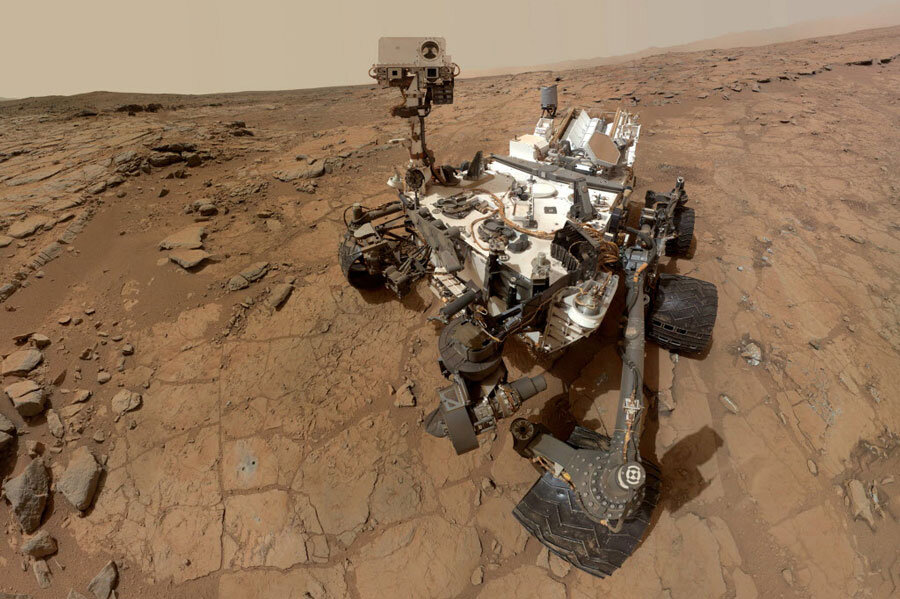Mars burped? NASA's Curiosity detects methane pulses that could hint at life
Loading...
In the annals of Mars exploration, Nov. 29, 2013, could well go down in history as the day Mars belched.
And NASA's Mars rover Curiosity was there to detect it – an unusually strong pulse of methane. Its unclear what the source of the methane is. One possibility is that it's biological in nature.
What is clear is that the detection of methane and other organics found in rock samples means the rover has met the second of its two broad objectives as it explores Mars' Gale Crater and the slopes of Mt. Sharp.
Within its first Martian year on the red planet, the rover met its first major goal by uncovering evidence of ancient riverbeds on the crater floor, along with minerals that testified to an early environment that would have been hospitable for microbial life.
While there, the rover gathered samples that ultimately proved to hold ancient organics. The samples were gathered in May 2013 from a rock formation dubbed Cumberland. Curiosity also has detected methane both as a persistent, low-level component of the atmosphere and in a surprising pulse. Over 60 Martian days, the pulse pushed concentrations of the gas to an average level 10 times higher than the tiny background amounts typically present. Then the pulse vanished.
"We were completely surprised," said Christopher Webster, a researcher at NASA's Jet Propulsion Laboratory in Pasadena, Calif., and the lead author of a paper reporting the results set to appear Friday in the journal Science. "It was an 'Oh my gosh!' moment."
In effect, Mars burped, said Sushil Atreya, a researcher at the University of Michigan at Ann Arbor and a member of Curiosity's science team during a briefing Tuesday announcing the results.
The emissions show that "Mars is currently active and that the subsurface is communicating with the atmosphere," Dr. Atreya said during a briefing announcing the results at the fall meeting of the American Geophysical Union, which is taking place in San Francisco through Friday.
The methane measurements in particular are striking of keen interest because they can have a current biological origin, although at this point that remains an open question.
The team has not found evidence for life on Mars, past or present, cautioned John Grotzinger, the mission's lead scientist, during the briefing. But, he added, a biological origin – past or present – for the methane pulses "is one of the few hypotheses we must consider as we go forward."
Ground-based observatories on Earth as well as Mars orbiters have detected Martian methane from various degrees of afar. But the results have been controversial. These emissions have been episodic, confined to specific regions, and failed to match model predictions for methane concentrations one might anticipate for a gas expected to persist in the Martian atmosphere for about 300 years, researchers say.
Curiosity has provided the first on-location methane measurements. The background amounts are small: some 7 methane molecules for every 10 billion molecules in Mars' atmosphere. That corresponds to a total of 5,000 metric tons of methane in the Martian air, compared with 500 million metric tons of methane in Earth's atmosphere. And it is less than models predict.
This background methane is likely the byproduct of interactions between the sun's ultraviolet light and organic molecules that lie on the surface. These molecules likely represent passengers that hitched ride to Mars on cosmic dust or micrometeoroids, Dr. Atreya explained.
Last November, however, Curiosity's tunable laser spectrometer – part of the Surface Analysis at Mars package aboard the rover – found the pronounced increase in methane concentrations.
Over the course of two months, the methane concentrations rose from 5.5 parts per billion to 9 parts per billion. Some six weeks after that peak measurement, concentrations fell to initial background levels.
The emissions are thought to have surfaced via a relatively weak source located within Gale Crater, or perhaps just outside of it, northward of the rover.
The ultimate origin of the methane in the pulses remains anyone's guess, researchers say.
If an underground aquifer is nearby, the methane could be fresh, stemming either from microbes or from water's interaction with minerals such as olivine, Atreya explained. The methane also could have an ancient source and have been trapped in tiny icy cocoons as calthrate hydrates. If the underground environment they occupy is stable, they can remain intact for billions of years. But if they appear in deposits near the surface, are disturbed by an impact or some other form of ground movement, and have pathways to the surface, the methane can escape.
As Curiosity continues to explore the foothills of Mt. Sharp, it will continue to sniff for methane, Dr. Grotzinger said. While the pulse was too tenuous for Curiosity to test it for a potential biological origin, the team has a game plan for analyzing any future pulses they detect. They will sample another pulse more frequently and study how it dissipates to get a better handle on the means by which the methane is destroyed once it escapes.
Likewise, the discovery of an ancient organic – chlorobenzene – in samples drilled from the Cumberland rock formation is helping the team lay out its game plan for Mt. Sharp and the continued hunt for organics there.
"This is a great moment for the mission," he said, adding later that Mars exploration is turning a corner. It is leaving behind the "Star Trek mode" where researchers build a spacecraft "to go out there and find something no one's found before," he said. Now, Mars exploration is about testing specific ideas about the planet by exploring a range of possibilities.






